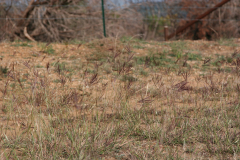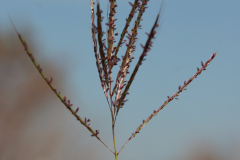King Ranch Bluestem
Bothriochloa ischaemum var. songarica
Poaceae
Description
King Ranch Bluestem is a perennial, warm season, introduced, aggressive bunchgrass with stems up to 47 inches or 120 cm arising from an almost flat crown. It is only stoloniferous when closely cut or grazed. The light green stems change the angle of growth at the nodes, turn up, and branch freely giving a wide spreading appearance to the plant. Stems turn a straw color when mature. Stem nodes of the songarica variant are hairless. Leaves, growing up to 8 inches or 20 cm long and 5mm wide, are thicker near the collar, and near the ligule, the surface may have sparse, long, stiff, papilla-based hairs. The stems are naked at the top. Each stem produces a loose, terminal seed head that is usually silvery and purplish. The seed head is composed of 3 to 8 spicate branches each up to 10 cm long which is longer than the seed head itself. King Ranch Bluestem flowers much of the year beginning as early as June. Both the sterile and fertile spikelets have slender, twisted, bent awns. The branches have fine, silky hairs but much less hair than found in other bluestem species. Fair grazing for both livestock and wildlife in the spring and summer.Habitat
This grass was widely available by 1949 and extensively seeded after the 1950s drought on degraded rangelands for soil and water conservation, and is now common along roadsides throughout Texas. It is native to southern and central Europe and Asia. It establishes rapidly on bare soils, outlasts other grasses, and often produces a monoculture. While preferring loam and clay soils, it will also grow in sand and is highly adaptable.Management Strategies
This is one of the state’s most undesirable weedy grasses and is very difficult to control. "Initial populations may be reduced by spot spraying with glycophosphate. After a seed bank is established, multiple treatment combinations will be necessary to keep it from spreading. Research has found plant suppression with multiple diskings or plowing, glycophoshate applications, and reseeding with competitive plant species.” - (M. Clayton, et al. Bluestem Grasses in Texas)Images
Plant Characteristics
Duration: Perennial
Stem Texture: Hairless/Smooth
Growth Habit: Bunch grass, Grasses
Season: Warm
Distribution
 : 01 - Pineywoods, 02 - Gulf Prairies and Marshes, 03 - Post Oak Savannah, 04 - Blackland Prairies, 05 - Cross Timbers and Prairies, 06 - South Texas Plains, 07 - Edwards Plateau, 08 - Rolling Plains, 09 - High Plains, 10 - Trans-Pecos
: 01 - Pineywoods, 02 - Gulf Prairies and Marshes, 03 - Post Oak Savannah, 04 - Blackland Prairies, 05 - Cross Timbers and Prairies, 06 - South Texas Plains, 07 - Edwards Plateau, 08 - Rolling Plains, 09 - High Plains, 10 - Trans-Pecos
Distributions
Distribution refers to the ecological region in Texas that a plant has been found. You can also view a clickable map.
Book: Know Your Grasses (B-182)
Collection: Grasses



